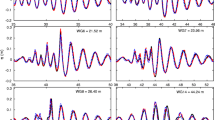Abstract
A two-dimensional numerical wave flume is developed to study the focused waves group propagation and the consequent breaking processes. The numerical model is based on the Reynolds-Averaged Navier-Stokes (RANS) equations, with the standard k-ε turbulence model to simulate the turbulence effects. To track the complicated and broken free-surface, the Volume Of Fluid (VOF) method is employed. The numerical model combines the “Partial Cell Treatment (PCT)” method with the “Locally Relative Stationary (LRS)” concept to treat the moving wave paddle so that various waves can be generated directly in a fixed Cartesian grid system. The theoretical results of the linear and nonlinear waves are used to validate the numerical wave flume firstly, and then a plunging breaking wave created by a focused waves group is simulated. The numerical results are compared to the experimental data and other simulation results, with very good agreements. The turbulence intensity, the flow field and the energy dissipation in the breaking processes are analyzed based on the numerical results. It is shown that the present numerical model is efficient and accurate for studying the waves group generation, the waves packet propagation, and the wave breaking processes.
Similar content being viewed by others
References
KHARIF C., PELINOVSKY E. Physical mechanisms of the rogue wave phenomenon[J]. European Journal of Mechanics B/Fluids, 2003, 22(6): 603–634.
RAPP R. J., MELVILLE W. K. Laboratory measurements of deep-water breaking wave[J]. Philosophical Transactions of the Royal Society of London A, 1990, 331(1622): 735–800.
LI Jin-xuan, LIU Shu-xue and HONG Key-yong. Numerical study of two-dimensional focusing waves[J]. China Ocean Engineering, 2008, 22(2): 253–266.
ZHAO Xi-zeng, SUN ZHAO-chen and LIANG Shu-xiu et al. A numerical method for nonlinear water waves[J]. Journal of Hydrodynamics, 2009, 21(3): 401–407.
NING D., TENG B. and TAYLOR R. E. et al. Numerical simulation of non-linear regular and focused waves in an infinite water-depth[J]. Ocean Engineering, 2008, 35(8–9): 887–899.
NING D., ZANG J. and LIU S. et al. Free-surface evolution and wave kinematics for nonlinear uni-dire-ctional focused wave groups[J]. Ocean Engineering, 2009, 36(15–16): 1226–1243.
BAI W., TAYLOR R. E. Numerical simulation of fully nonlinear regular and focused wave diffraction around a vertical cylinder using domain decomposition[J]. Applied Ocean Research, 2007, 29(1–2): 55–71.
LIN P., LIU P. L. -F. A numerical study of breaking waves in the surf zone[J]. Journal of Fluid Mechanics, 1998, 359: 239–264.
KETABDARI M. J., NOBARI M. R. H. and LARMAEI M. M. Simulation of waves group propagation and breaking in coastal zone using a Navier-Stokes solver with an improved Vof free surface treatment[J]. Applied Ocean Research, 2008, 30(2): 130–143.
CHEN G., KHARIF C. Two-dimensional Navier-Stokes simulation of breaking waves[J]. Physics of Fluids, 1999, 11(1): 121–133.
WANG Z, YANG J. and KOO B. et al. A coupled level set and volume-of-fluid method for sharp interface simulation of plunging breaking waves[J]. International Journal of Multiphase Flow, 2009, 35(3): 227–246.
LIANG Xiu-feng, YANG Jian-min and LI Jun et al. Numerical simulation of irregular wave-simulating irregular wave train[J]. Journal of Hydrodynamics, 2010, 22(4): 537–545.
ZHAO Xi-zeng, HU Chang-hong and SUN Zhao-chen. Numerical simulation of extreme wave generation using Vof method[J]. Journal of Hydrodynamics, 2010, 22(4): 466–477.
LIN P., XU W. NEWFLUNE: A numerical water flume for two-dimensional turbulent free surface flows[J]. Journal of Hydraulic Research, 2006, 44(1): 79–93.
LIN P. A fixed-grid model for simulation of a moving body in free surface flows[J]. Computers and Fluids, 2007, 36(3): 549–561.
ZHOU Bin-zhen, NING De-zhi and TENG Bin. Realtime simulation of waves generated by a wave maker[J]. Chinese Journal of Hydrodynamics, 2009, 24(4): 406–416(in Chinese).
RIDER W. J., KOTHE D. B. Reconstructing volume tracking[J]. Journal of Computational Physics, 1998, 141(2): 112–152.
DOMMERMUTH D. G., YUE D. K. P. and LIN W. M. et al. Deep-water plunging breakers: A comparison between potential theory and experiments[J]. Journal of Fluid Mechanics, 1988, 189: 423–442.
LIN P., LIU P. L.-F. Turbulence transport, vorticity dynamics, and solute mixing under plunging breaking waves in surf zone[J]. Journal of Geophysical Research-Oceans, 1998, 103(C8): 15677–15694.
Author information
Authors and Affiliations
Corresponding author
Additional information
Project supported by the National Natural Science Foundation of China (Grant No. 51061130547).
Biography: HUANG Zong-liu (1984-), Male, Ph. D. Candidate
Rights and permissions
About this article
Cite this article
Huang, Zl., Lin, Pz. Numerical Simulation of Propagation and Breaking Processes of a Focused Waves Group. J Hydrodyn 24, 399–409 (2012). https://doi.org/10.1016/S1001-6058(11)60261-8
Received:
Revised:
Published:
Issue Date:
DOI: https://doi.org/10.1016/S1001-6058(11)60261-8



